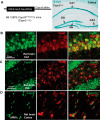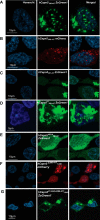Calpain 5 is highly expressed in the central nervous system (CNS), carries dual nuclear localization signals, and is associated with nuclear promyelocytic leukemia protein bodies
- PMID: 24838245
- PMCID: PMC4094050
- DOI: 10.1074/jbc.M114.575159
Calpain 5 is highly expressed in the central nervous system (CNS), carries dual nuclear localization signals, and is associated with nuclear promyelocytic leukemia protein bodies
Abstract
Calpain 5 (CAPN5) is a non-classical member of the calpain family. It lacks the EF hand motif characteristic of classical calpains but retains catalytic and Ca(2+) binding domains, and it contains a unique C-terminal domain. TRA-3, an ortholog of CAPN5, has been shown to be involved in necrotic cell death in Caenorhabditis elegans. CAPN5 is expressed throughout the CNS, but its expression relative to other calpains and subcellular distribution has not been investigated previously. Based on relative mRNA levels, Capn5 is the second most highly expressed calpain in the rat CNS, with Capn2 mRNA being the most abundant. Unlike classical calpains, CAPN5 is a non-cytosolic protein localized to the nucleus and extra-nuclear locations. CAPN5 possesses two nuclear localization signals (NLS): an N-terminal monopartite NLS and a unique bipartite NLS closer to the C terminus. The C-terminal NLS contains a SUMO-interacting motif that contributes to nuclear localization, and mutation or deletion of both NLS renders CAPN5 exclusively cytosolic. Dual NLS motifs are common among transcription factors. Interestingly, CAPN5 is found in punctate domains associated with promyelocytic leukemia (PML) protein within the nucleus. PML nuclear bodies are implicated in transcriptional regulation, cell differentiation, cellular response to stress, viral defense, apoptosis, and cell senescence as well as protein sequestration, modification, and degradation. The roles of nuclear CAPN5 remain to be determined.
Keywords: Calpain; Nuclear Transport; Protease; SUMO-interacting Motif (SIM); SUMOylation.
© 2014 by The American Society for Biochemistry and Molecular Biology, Inc.
Figures








Similar articles
-
The C2 domain of calpain 5 contributes to enzyme activation and membrane localization.Biochim Biophys Acta Mol Cell Res. 2021 Jun;1868(7):119019. doi: 10.1016/j.bbamcr.2021.119019. Epub 2021 Mar 31. Biochim Biophys Acta Mol Cell Res. 2021. PMID: 33811937 Free PMC article.
-
RNF38 encodes a nuclear ubiquitin protein ligase that modifies p53.Biochem Biophys Res Commun. 2013 Nov 1;440(4):473-8. doi: 10.1016/j.bbrc.2013.08.031. Epub 2013 Aug 22. Biochem Biophys Res Commun. 2013. PMID: 23973461 Free PMC article.
-
A nucleolar targeting signal in PML-I addresses PML to nucleolar caps in stressed or senescent cells.J Cell Sci. 2007 Sep 15;120(Pt 18):3219-27. doi: 10.1242/jcs.007492. J Cell Sci. 2007. PMID: 17878236
-
Targeting promyelocytic leukemia protein: a means to regulating PML nuclear bodies.Int J Biol Sci. 2009 May 22;5(4):366-76. doi: 10.7150/ijbs.5.366. Int J Biol Sci. 2009. PMID: 19471587 Free PMC article. Review.
-
PML nuclear bodies.Cold Spring Harb Perspect Biol. 2010 May;2(5):a000661. doi: 10.1101/cshperspect.a000661. Epub 2010 Apr 21. Cold Spring Harb Perspect Biol. 2010. PMID: 20452955 Free PMC article. Review.
Cited by
-
The C2 domain of calpain 5 contributes to enzyme activation and membrane localization.Biochim Biophys Acta Mol Cell Res. 2021 Jun;1868(7):119019. doi: 10.1016/j.bbamcr.2021.119019. Epub 2021 Mar 31. Biochim Biophys Acta Mol Cell Res. 2021. PMID: 33811937 Free PMC article.
-
Calpain signaling: from biology to therapeutic opportunities in neurodegenerative disorders.Front Vet Sci. 2023 Sep 5;10:1235163. doi: 10.3389/fvets.2023.1235163. eCollection 2023. Front Vet Sci. 2023. PMID: 37732142 Free PMC article. Review.
-
Comprehensive analysis of prognostic value and immune infiltration of calpains in pancreatic cancer.J Gastrointest Oncol. 2021 Dec;12(6):2600-2621. doi: 10.21037/jgo-21-705. J Gastrointest Oncol. 2021. PMID: 35070391 Free PMC article.
-
Calpain-Inhibitors Protect Frataxin-Deficient Dorsal Root Ganglia Neurons from Loss of Mitochondrial Na+/Ca2+ Exchanger, NCLX, and Apoptosis.Neurochem Res. 2021 Jan;46(1):108-119. doi: 10.1007/s11064-020-03020-3. Epub 2020 Apr 6. Neurochem Res. 2021. PMID: 32249386
-
Regulatory role of calpain in neuronal death.Neural Regen Res. 2018 Mar;13(3):556-562. doi: 10.4103/1673-5374.228762. Neural Regen Res. 2018. PMID: 29623944 Free PMC article. Review.
References
-
- Ono Y., Sorimachi H. (2012) Calpains: an elaborate proteolytic system. Biochim. Biophys. Acta 1824, 224–236 - PubMed
-
- Goll D. E., Thompson V. F., Li H., Wei W., Cong J. (2003) The calpain system. Physiol. Rev. 83, 731–801 - PubMed
-
- Franco S. J., Huttenlocher A. (2005) Regulating cell migration: calpains make the cut. J. Cell Sci. 118, 3829–3838 - PubMed
-
- Wang K. K. (2000) Calpain and caspase: can you tell the difference? Trends Neurosci. 23, 20–26 - PubMed
Publication types
MeSH terms
Substances
Grants and funding
LinkOut - more resources
Full Text Sources
Other Literature Sources
Molecular Biology Databases
Miscellaneous

